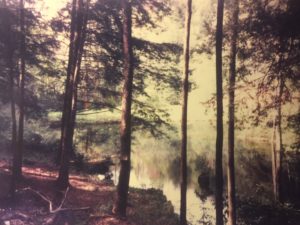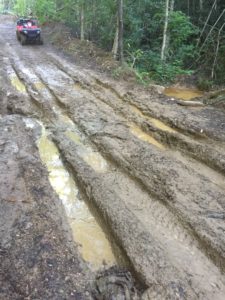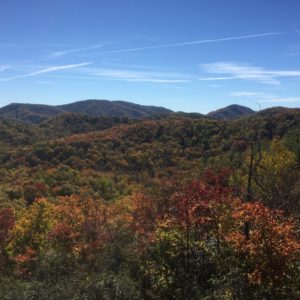I was still up when I heard a knock at the door. It was Leonard Phillips’ teenage daughter, coming home from her date. I cracked the door about six inches, told her she couldn’t come in, said her family was at their lake house, and closed the door.
Earlier that evening, Phillips had invited me to stay overnight by myself in his family’s home in Robbinsville, N.C.
I only remember two things about that house: It had three places to eat. [I had been in houses with two places to eat, but never three.] And there were orange, satin sheets on the bed I slept in.
Next morning, when I walked back into Phillips Restaurant, Leonard Phillips was sitting there, having breakfast, and I joined him. Turns out, his family owned the restaurant.
The land auction I had come for was held in the Graham County High School gymnasium, and it was full.
The rules were simple: whoever won the first bid could buy anything or everything at that price per acre. After they made their selection, or selections, the auction started over. And over and over. That pretty much forced you to figure out the most you could pay, and bid it, because you had no way of knowing when a winning bidder would choose the tract you wanted.
I hoped to buy Tract #45, 121 acres on the middle fork of the Juanite. It had everything my brother-in-law, Jack Lambert, and I wanted: it topped out on a ridge; it had creeks running through it; it bordered the Nantahala National Forest – and it was remote.
Jack was a lieutenant colonel in the Air Force and made a lot more money than I did. The most I could afford to pay for that much land was $120 an acre. That may not seem like much now, but it was not nothing then. Adjusted for inflation, $120 an acre in 1971 would be about $715 an acre now.
The opening bid was $750 an acre — $4,470 an acre in 2016 dollars.
After that, the price fell pretty fast and then, more slowly. Finally it dropped under $200 an acre, then under $150. Tract #45 was still on the board.
When the winning bids dropped into the mid-$130s Phillips came over to where I was sitting and told me that the owner, Bemis Hardwood Timber Co., was about to stop the auction.
If you want to buy land, he said, buy it now.
I bought 57 acres adjoining the land I really wanted, for $136 an acre. But Bemis did not stop the auction right away and, little by little, the price kept dropping. At last I heard myself say, “$120!” I didn’t win, but I had made up my mind that no one else was going to buy our land for the price I could have paid.
And then Bemis did stop the auction. The company announced that it would sell any tract that was left for $120 an acre. I went to the auctioneer and told him I wanted to give back Tract #44 and buy Tract #45 — would he trade?
The auctioneer, whose pay must have been tied to total sales, did the math: 57 acres x $136 = $7,752; 121 acres x $120 = $14,520. He traded and Jack and I had our mountain land. We called it “Snowbird” because that’s where it is, in the Snowbird Mountains of Western North Carolina.


Coming Friday: Silly Man
